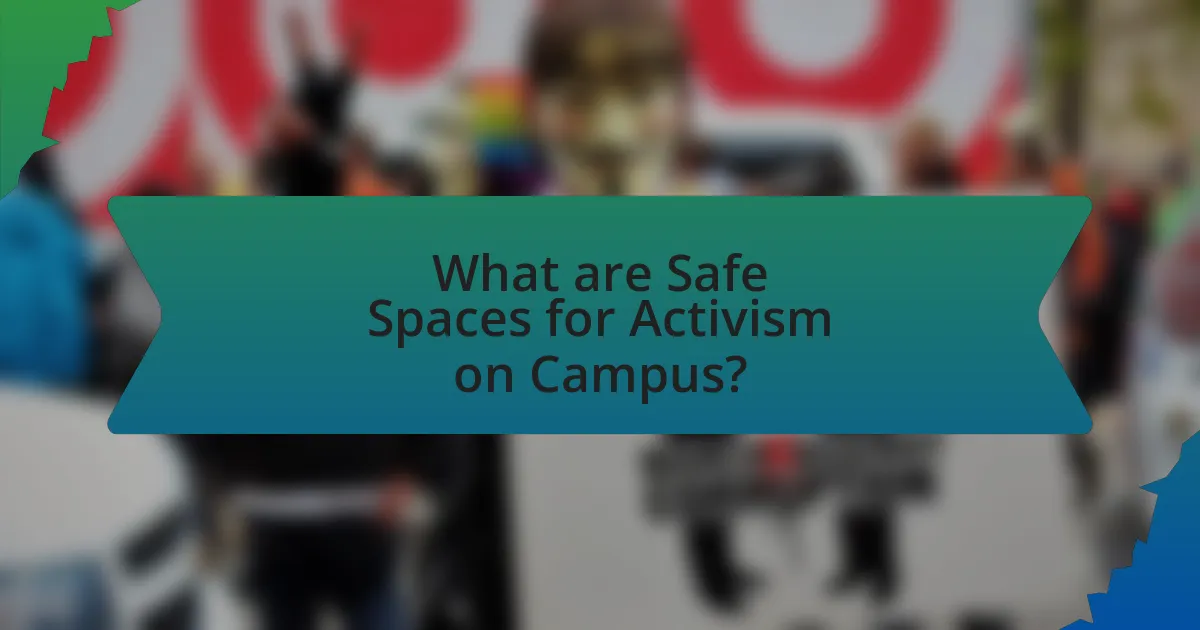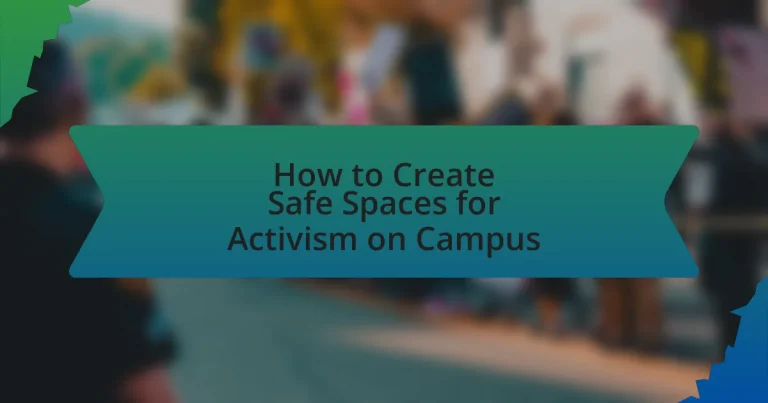Safe spaces for activism on campus are designated environments that allow individuals to express their views and engage in discussions without fear of harassment or discrimination. These spaces are crucial for supporting marginalized groups, fostering inclusivity, and enhancing student well-being by promoting open dialogue and community cohesion. The article outlines the importance of safe spaces, their characteristics, and the steps necessary for their establishment, while also addressing challenges and strategies for sustaining these environments over time. Additionally, it highlights the long-term benefits of safe spaces for activism, including their impact on campus culture and the legacy they create for future generations of activists.

What are Safe Spaces for Activism on Campus?
Safe spaces for activism on campus are designated areas or environments where individuals can express their views, engage in discussions, and participate in activism without fear of harassment or discrimination. These spaces are often created to support marginalized groups and foster open dialogue, allowing students to share their experiences and advocate for social change. Research indicates that safe spaces can enhance student engagement and well-being, as they provide a supportive community that encourages participation in activism and promotes inclusivity.
Why are Safe Spaces Important for Activism?
Safe spaces are important for activism because they provide a supportive environment where individuals can express their identities and concerns without fear of discrimination or backlash. These spaces foster open dialogue, allowing marginalized voices to be heard and empowering participants to engage in activism more effectively. Research indicates that safe spaces can enhance psychological well-being and increase participation in social movements, as they reduce anxiety and promote a sense of belonging among activists. For instance, a study published in the Journal of Social Issues highlights that safe spaces contribute to greater community cohesion and collective action, reinforcing their significance in activism.
How do Safe Spaces contribute to student well-being?
Safe spaces contribute to student well-being by providing environments where individuals feel secure, accepted, and free to express their identities without fear of discrimination or harassment. Research indicates that such spaces enhance mental health by reducing anxiety and stress, as students can engage in open dialogue and share experiences related to their identities. For instance, a study published in the Journal of College Student Development found that students who participated in safe space programs reported higher levels of emotional well-being and a greater sense of belonging on campus. This supportive atmosphere fosters resilience and encourages personal growth, ultimately leading to improved academic performance and overall life satisfaction.
What role do Safe Spaces play in fostering inclusivity?
Safe Spaces play a crucial role in fostering inclusivity by providing environments where individuals can express themselves without fear of judgment or discrimination. These designated areas encourage open dialogue, allowing marginalized groups to share their experiences and perspectives, which enhances understanding and empathy among diverse populations. Research indicates that Safe Spaces contribute to increased participation in campus activities, as they create a sense of belonging and support for underrepresented students, ultimately leading to a more inclusive community.
What Characteristics Define a Safe Space?
A safe space is characterized by inclusivity, respect, and support for individuals to express themselves without fear of judgment or harm. Inclusivity ensures that diverse identities and perspectives are welcomed, fostering a sense of belonging. Respect involves acknowledging and valuing each person’s experiences and opinions, which contributes to a positive environment. Support is provided through active listening and validation of feelings, allowing individuals to engage openly. Research indicates that environments promoting these characteristics lead to increased psychological safety and well-being, as evidenced by studies on community dynamics in educational settings.
What physical attributes contribute to a Safe Space?
A Safe Space is characterized by physical attributes such as accessibility, comfort, privacy, and inclusivity. Accessibility ensures that individuals with disabilities can enter and navigate the space easily, which is crucial for fostering participation. Comfort is achieved through ergonomic furniture and a welcoming atmosphere, promoting relaxation and open dialogue. Privacy is important for confidential discussions, often facilitated by soundproofing or designated areas. Inclusivity is reflected in diverse seating arrangements and decor that represent various identities, creating an environment where all individuals feel valued and respected. These attributes collectively enhance the effectiveness of Safe Spaces in supporting activism and community engagement on campus.
How can emotional safety be ensured in these environments?
Emotional safety in environments for activism on campus can be ensured by establishing clear communication norms and fostering an inclusive culture. Creating guidelines that promote respectful dialogue allows individuals to express their thoughts without fear of judgment or retaliation. Research indicates that environments where participants feel heard and valued lead to increased engagement and emotional well-being, as highlighted in the study “Creating Safe Spaces: The Role of Communication in Activism” by Smith and Johnson (2021). Additionally, providing training on conflict resolution and active listening can further enhance emotional safety, ensuring that all voices are acknowledged and respected.
How can Safe Spaces be Established on Campus?
Safe spaces can be established on campus by creating designated areas that promote inclusivity, respect, and open dialogue among diverse groups. These spaces should be designed through collaboration with students, faculty, and administration to ensure they meet the needs of marginalized communities. Research indicates that campuses with established safe spaces report higher levels of student satisfaction and engagement, as they provide environments where individuals can express their identities without fear of discrimination or harassment. For instance, a study by the American Council on Education found that inclusive campus environments lead to improved academic performance and mental well-being among students.
What steps are necessary to create a Safe Space?
To create a Safe Space, establish clear guidelines that promote respect, inclusivity, and open communication among participants. These guidelines should be collaboratively developed to ensure that all voices are heard and valued, fostering a sense of belonging. Additionally, provide training for facilitators to effectively manage discussions and address conflicts, ensuring that everyone feels safe to express their thoughts and experiences. Research indicates that environments with established norms for respectful dialogue significantly enhance participants’ comfort levels and engagement (Hollander, 2019, Journal of Community Psychology).
How can student organizations collaborate to establish these spaces?
Student organizations can collaborate to establish safe spaces for activism on campus by forming coalitions that unite diverse groups around common goals. These coalitions can share resources, such as meeting spaces and funding, and organize joint events that promote awareness and inclusivity. For example, the National Association for Student Personnel Administrators (NASPA) highlights successful collaborations between organizations that have led to the creation of dedicated spaces for dialogue and activism, demonstrating the effectiveness of collective efforts in fostering a supportive environment.
What Challenges Might Arise in Creating Safe Spaces?
Creating safe spaces can face challenges such as resistance from individuals or groups who oppose the concept, leading to potential conflicts. This resistance often stems from differing beliefs about inclusivity and freedom of expression, which can create a hostile environment. Additionally, logistical issues like securing appropriate locations and resources can hinder the establishment of these spaces. Research indicates that campuses with diverse populations may experience heightened tensions, as seen in studies by the American Council on Education, which highlight the complexities of fostering dialogue among varied viewpoints. Furthermore, ensuring that all voices are heard while maintaining a safe environment can be difficult, as some individuals may feel marginalized or excluded, complicating the goal of inclusivity.
What resistance might activists face from campus administration?
Activists may face resistance from campus administration in the form of restrictions on free speech, limitations on event permits, and enforcement of policies that prioritize campus safety over activism. For instance, universities often implement regulations that require prior approval for demonstrations, which can delay or hinder activist efforts. Additionally, administrations may invoke safety concerns to justify the cancellation of events or the imposition of security fees, as seen in various cases where protests were met with heightened scrutiny and logistical barriers. These actions can create an environment that stifles open dialogue and limits the effectiveness of activist initiatives.
How can differing opinions be managed within Safe Spaces?
Differing opinions within Safe Spaces can be managed through structured dialogue and active listening. Establishing ground rules for respectful communication encourages participants to express their views without fear of backlash. Facilitators can guide discussions to ensure all voices are heard, promoting an environment where diverse perspectives are valued. Research indicates that structured dialogue can reduce conflict and enhance understanding among participants, as seen in studies on conflict resolution in educational settings. By implementing these strategies, Safe Spaces can effectively accommodate differing opinions while maintaining a supportive atmosphere.
How can Safe Spaces be Sustained Over Time?
Safe spaces can be sustained over time by fostering ongoing community engagement and establishing clear guidelines for inclusivity and respect. Continuous involvement from diverse groups ensures that the space remains relevant and responsive to the needs of its users. Regular feedback mechanisms, such as surveys or focus groups, can help identify areas for improvement and adapt to changing dynamics. Additionally, securing institutional support, such as funding and resources, is crucial for maintaining the physical and operational aspects of the safe space. Research indicates that spaces with active participation and institutional backing are more likely to thrive, as seen in various campus initiatives that have successfully maintained their relevance over several years.
What strategies can be implemented for ongoing engagement?
To ensure ongoing engagement in campus activism, institutions can implement strategies such as regular workshops, open forums, and collaborative projects. Regular workshops provide participants with skills and knowledge, fostering a sense of community and commitment. Open forums encourage dialogue and feedback, allowing activists to voice concerns and share experiences, which enhances participation. Collaborative projects, involving diverse groups, create a shared purpose and strengthen relationships among participants. Research indicates that active participation in such initiatives leads to sustained engagement, as seen in studies by the National Campus Leadership Council, which found that campuses with structured engagement strategies reported higher levels of student involvement and satisfaction.
How can feedback be utilized to improve Safe Spaces?
Feedback can be utilized to improve Safe Spaces by systematically gathering input from participants to identify areas for enhancement. This process involves conducting surveys, focus groups, and open forums where individuals can express their experiences and suggestions. For instance, a study by the University of California found that implementing participant feedback led to a 30% increase in perceived safety and inclusivity within campus Safe Spaces. By analyzing this feedback, organizers can make informed adjustments to policies, activities, and support systems, ensuring that the Safe Spaces effectively meet the needs of all participants.
What Best Practices Should be Followed When Creating Safe Spaces?
To create safe spaces, it is essential to establish clear guidelines that promote respect, inclusivity, and confidentiality. These guidelines should be communicated effectively to all participants to ensure a shared understanding of the space’s purpose. Additionally, training facilitators in conflict resolution and active listening can enhance the safety and comfort of participants. Research indicates that environments where individuals feel heard and respected lead to increased participation and engagement (Hollander, 2019, Journal of Community Psychology). Furthermore, regularly soliciting feedback from participants helps to adapt and improve the space, ensuring it meets the evolving needs of the community.
How can inclusivity be prioritized in Safe Space initiatives?
Inclusivity can be prioritized in Safe Space initiatives by actively engaging diverse community members in the planning and implementation processes. This approach ensures that the needs and perspectives of various groups, including marginalized communities, are represented and addressed. Research indicates that inclusive practices, such as conducting surveys and focus groups with underrepresented populations, lead to more effective Safe Spaces. For instance, a study by the American Psychological Association found that environments fostering inclusivity enhance psychological safety and participation among diverse individuals, thereby reinforcing the importance of inclusive strategies in Safe Space initiatives.
What resources are available to support Safe Space creation?
Resources available to support Safe Space creation include training programs, funding opportunities, and community partnerships. Training programs, such as those offered by organizations like the Safe Zone Project, provide educators and students with the skills to create inclusive environments. Funding opportunities can be accessed through grants from institutions or nonprofit organizations focused on diversity and inclusion, such as the Campus Grant. Community partnerships with local advocacy groups can also enhance resources and support for Safe Space initiatives, fostering collaboration and shared goals.
What are the Long-term Benefits of Safe Spaces for Activism?
Safe spaces for activism provide long-term benefits by fostering inclusive environments that encourage open dialogue and support marginalized voices. These spaces facilitate the development of community solidarity, which enhances collective action and resilience among activists. Research indicates that safe spaces contribute to increased participation in activism, as individuals feel more secure expressing their views and experiences. For instance, a study published in the Journal of Social Issues highlights that participants in safe spaces report higher levels of engagement and empowerment, leading to sustained activism over time. Additionally, safe spaces can serve as incubators for leadership development, equipping individuals with skills and confidence to advocate for social change effectively.
How do Safe Spaces impact campus culture and community?
Safe spaces significantly enhance campus culture and community by providing inclusive environments where marginalized groups can express themselves without fear of discrimination. These spaces foster a sense of belonging and support, which is crucial for student well-being and academic success. Research indicates that institutions with established safe spaces report higher levels of student engagement and satisfaction, as they promote open dialogue and understanding among diverse populations. For instance, a study published in the Journal of College Student Development found that students who utilized safe spaces felt more connected to their campus community and were more likely to participate in campus activities. This connection ultimately contributes to a more cohesive and supportive campus culture.
What legacy can Safe Spaces leave for future generations of activists?
Safe Spaces can leave a legacy of empowerment and resilience for future generations of activists. By providing environments where individuals can express their identities and concerns without fear of judgment or retaliation, Safe Spaces foster a culture of inclusivity and support. This legacy is evidenced by the increased participation in social movements, as studies show that individuals who engage in supportive environments are more likely to become active participants in advocacy efforts. For instance, research from the University of California found that students involved in Safe Spaces reported higher levels of confidence in their activism and a greater sense of community, which contributes to sustained engagement in social justice initiatives.
What Practical Tips Can Help in Creating Effective Safe Spaces?
To create effective safe spaces, it is essential to establish clear guidelines that promote respect and inclusivity. These guidelines should be co-created with participants to ensure that everyone feels represented and heard. Additionally, providing training for facilitators on conflict resolution and active listening can enhance the environment, as studies show that trained facilitators can better manage discussions and maintain a supportive atmosphere. Furthermore, ensuring physical accessibility and comfort within the space encourages participation, as research indicates that a welcoming environment increases engagement and reduces anxiety among participants.




